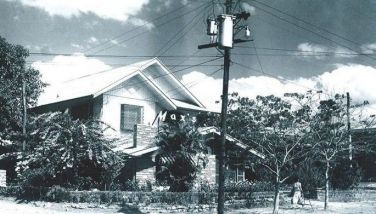Secretary Coloma up close

These days, the man we often see on television explaining the President’s decisions is Secretary Herminio “Sonny†Coloma Jr., head of the Presidential Communications Operations Office (PCOO). He describes his job as that of a “communicator on behalf of the President to inform the people about his position on key issues and to convey his message on what government is doing to move the country on the path to development and the fulfillment of the people’s aspirations.â€
In addition to his being a communicator, Coloma was recently designated Presidential Spokesperson. Those jobs are not easy, to say the least. He finds them “difficult and challenging, especially on account of the continuous exposure to the media. I refer specifically to the ‘toothpaste tube’ challenge: whatever I say, I cannot retrieve those words anymore after I have expressed myself. There is a high premium on being correct (or accurate) all the time, and on using clear and concise language that would be prone to misinterpretation or misunderstanding.â€
The PCOO is part of the presidential communication group. Called “disseminator,†it provides direct media coverage and operations support for the Office of the President through the News Information Bureau, Philippine News Agency, Philippine Information Agency, Intercontinental Broadcasting Corp., RPN 9, NBN 4, PBS-Radio-Television Malacanang, Bureau of Communications Services, National Printing Office, APO Production Unit, and OP web Development Office.
PCOO’s functions are separate from those of the Presidential Communications Development and Strategic Planning Office (PCDSPO), then headed by Secretary Ricky Carandang, whose main task is “messaging†through speech-writing and preparation of messages from the President given to specific organizations, for example, souvenir programs of events.
“Messaging†is also carried out principally by the Presidential Spokesperson, Secretary Edwin Lacierda, and his Deputy Spokesperson, Abigail Valte. They handle the conduct of the daily briefings for the Malacanang Press Corps. The presidential spokesperson is separate and distinct from PCOO and PCDSPO, and is deemed part of the Office of the President.
Coloma, who will turn 60 in March, is unassuming and soft-spoken approachable, and easily communicating the President’s decisions mostly in Pilipino. A staff writes the President’s speeches, but the President first shares with them a “mental map†of what he intends to cover. “In a very real sense,†says Coloma, “the President is the principal author of his own speeches. He does not believe in ‘ghost-written’ speeches. He prefers brief speeches that he is able to deliver under ten minutes. He is not given to flowery oratory. He prefers simple and clear language.â€
Coloma is where he is now not because of friendship or being a shooting buddy of the President. A professor at the Asian Institute of Management, his view of Noynoy as the right man to lead the country made him join the Noynoy Aquino Media Bureau during the 2010 presidential campaign. (He did not work for the Jejomar Binay vice-presidential campaign, as perceived by some sectors.) Working as a volunteer in the Noynoy Aquino bureau from November 2009 flowed seamlessly into working for the Benigno S. Aquino III presidency. He and other fellow volunteers from the campaign organized the program for the new President’s inauguration while awaiting the formal enactment of Executive Order No. 4 that created the Palace communications group.
Sonny has an AB degree, major in political science, from the University of the Philippines. He was a student activist during the First Quarter Storm and he spent the first 47 days of martial law as a political detainee in camp Crame. He also holds an MBA (with distinction) from the Asian Institute of Management, AIM, and a PhD in philosophy from the Southeast Asian Inter-Disciplinary Development Institute’s School of Organization Development.
His first job (March 1974) was with far East Bank and Trust Co., as editor of the bank publication; altogether he worked for ten years with the bank. He worked briefly as top executive at various private business corporations. He has been a professor at AIM since 1988. He joined AIM after opting out of corporate life. “At the ripe young age of 35 and with a seven-year-old daughter, I thought that I preferred a gentler and kinder pace of work that would enable me to spend more quality time with the family.â€
Since 1988, he has taken five work leaves from AIM in view of jobs with the government as DAR undersecretary, DOTC undersecretary, and head of the Presidential Management Staff under President Corazon Aquino. He served briefly as president of North Luzon Railway Corp. (Nothrail). He was DOTC undersecretary in the Estrada administration from 1998 to 2001, resigning eight months before the convening of the impeachment trial.
Comparing the management styles of the two Aquino presidents, he says, “They are both good listeners and consultative. President Cory seemed to be more of a big-picture, conception thinker. President Noynoy is also a big-picture person. He delves into details and is very analytical in approach. Both of them have made me feel very comfortable in working with them.â€â€¨
Is he happy working with President Noynoy Aquino? “Yes,†he says without hesitation. “Yes, I am. I believe I am where I really want to be, doing what I am doing for the President.â€
“To the extent that the people know and appreciate what their President and government are doing for them – and this is reflected in periodic results and public opinion surveys – then we in the communications group are able to measure how effective we have been in performing our duty.â€
The privately-owned media, however, may not be too happy about some events, for example, government action on the Luneta hostage-taking incident. Sonny says, “The regrettable outcome of the Luneta hostage-taking incident was difficult to explain in the immediate aftermath, given the massive outrage that it created, both here and abroad. Those that criticized the administration severely did so with the benefit of the clearest of all vision: hindsight. Would they have done better or differently if they were the decision-makers?â€
It is the task of communicators to explain and clarify the President’s decisions and all the actions taken by him and his administration “so that these are sufficiently understood by all stakeholders, especially the mass media that convey information to our people,†Coloma says. “Given the prevailing culture of transparency, there is every opportunity for fact-checking; hence, it is difficult to imagine a scenario where there will be gross misrepresentation or distortion of what the President says or what his administration does. Those that insist on peddling lies or sowing intrigue soon find themselves losing credibility among our people.â€
Should the President worry if he’s branded unpopular? Reply: “That the President continues to enjoy consistently high performance approval and trust ratings well after the mid-point of his term is a definite source of strength. Whenever the President is asked about occasional declines in public approval or trust ratings, he always says, ‘I would rather do right by our people and fulfill my sworn mandate.’â€
What are his plans after 2016? “To return to my work as professor at AIM, and to be able to play golf more than once a week.â€
* * *
Email:dominitorrevillas@gmail.com
- Latest
- Trending



























